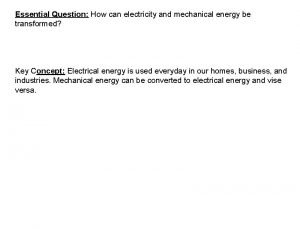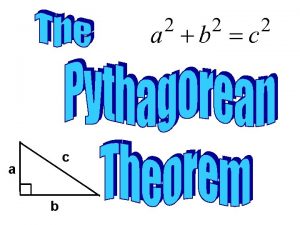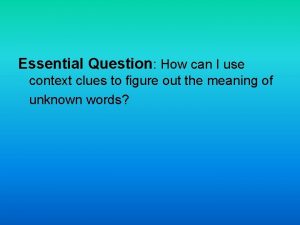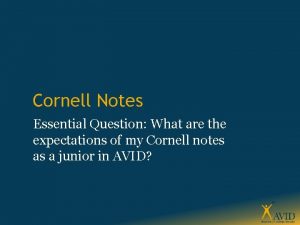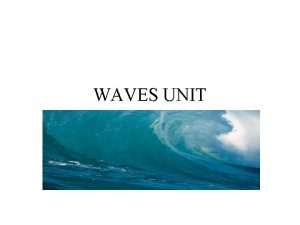Unit 2 Waves ESSENTIAL QUESTION WHAT ARE WAVES











- Slides: 11

Unit 2 -Waves ESSENTIAL QUESTION: WHAT ARE WAVES?

Recall 2. Liquid Matter: Anything that has mass and takes up space. 3. Gas States of Matter: 1. Solid Click on link below to watch video: https: //www. youtube. com/watch? v=s. Kvo. Vzuk. Ho&feature=youtu. be&t=30

Recall Ø Force: is a push or a pull Ø When a force happens it can create a vibration. Ø Vibration: a repeated back-and-forth or up-anddown motion.

What are waves? Ø Waves are created from a force. ØThey carry energy through empty space or through a medium WITHOUT transporting matter. ØA medium is a material which waves can travel. ØCan be: a solid, a liquid, or a gas ØWhen traveling through a medium, the particles in the medium are not carried with it. ØWhen there is not a medium only one type of wave can travel through empty space.

Demonstration: Watch the following 2 videos movement of matter wave movement demo

Types of Waves There are 2 categories that waves can be divided into: 1. Mechanical: Ømust have a medium ØCan also be separated into how the particles vibrate. Mechanical waves can move as a compressional wave or a transverse wave. 2. Electromagnetic: Øuses a medium, but CAN travel with out a medium in empty space ØThese waves will only travel as a transverse wave

Waves Mechanical Waves Must have a Medium Compressional Transverse Electromagnetic Waves Can travel WITHOUT medium Transverse

Movement of Waves 1. Compressional: (longitudinal) ◦ Move by pushing the particles together and then pulling apart ◦ Where the particles are pushed together; the area is called a compression ◦ Where the particles are pulled apart; the area is called a rarefaction Draw the waves into your notes!!! 1. Transverse: ◦ Move by making the particles go up and down or back and forth ◦ The highest point of a transverse wave is called a crest ◦ The lowest point of a transverse wave is called a trough

Characteristics of Transverse Waves Transverse waves only – we will not be studying the same characteristics for compressional Wavelength (λ): a measurement of the distance from one crest to the very next crest. Amplitude: a measurement of the distance between a line through the middle of a wave and a crest or trough ◦ The taller the wave the higher the amplitude Frequency (ƒ): a measurement of how many waves pass a point in a certain amount of time ◦ The higher the frequency the closer the waves are together

Amplitude changes – the taller the more energy Frequency changes – the closer the waves are the more energy Draw waves into your notes that are labeled correctly and show low and high amplitude and low and high frequency!!!

Characteristics of Transverse Waves Speed: Recall v=d/t ◦ the measurement of the distance a wave travels in a certain amount of time. ◦ Speed depends on type of wave and the type of medium it is traveling through ◦ If a wave is traveling through one type of matter and then moves to another; the speed will change ◦ Frequencies will travel though empty space at the same speed.
 Antigentest åre
Antigentest åre Costas de espaã±a
Costas de espaã±a Plamatic acid
Plamatic acid Language
Language Pythagorean theorem essential questions
Pythagorean theorem essential questions Essential question generator
Essential question generator Essential question for pythagorean theorem
Essential question for pythagorean theorem Essential questions for figurative language
Essential questions for figurative language Individual vs. society
Individual vs. society Essential question for context clues
Essential question for context clues Cornell notes essential question
Cornell notes essential question The art of asking essential questions
The art of asking essential questions





